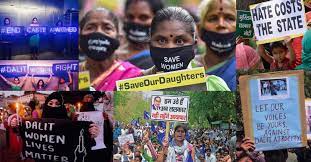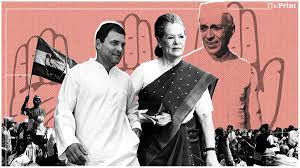Selective Empowerment: Can we claim to be truly free while Dalit women still struggle for justice?

Multiple oppressions that require police and court response and creative affirmative action for diversity is needed but resisted.
Thrice Oppressed, is a reasoned term for Dalit and Muslim women, burdened as they are with caste oppression, economic hurdles and the overarching burden of patriarchy.
With all the accused in the Hathras gang rape case were acquitted on charges of rape, (only one convicted for culpable homicide not amounting to murder) the discourse on sexual violence and caste discrimination especially faced by Dalit women is both germane and timely. An apt focus for International Women’s Day?
While women’s day brings out the happy emogis and businesses capitalise on the day as a celebration offering “women’s special” offers, little does one talk about the harsh realities that plague everyday lives of the thrice oppressed Dalit women. What a Dalit woman needs is justice, dignity at par with any other woman, equal opportunities, safeguarding of her rights by not just the courts but law enforcement agencies as well. This, with dignified social status that actually treats her as equal.
2023 and the life and struggles of the Dalit woman deserves special scrutiny. Intrepid articulations and struggles have brought issues to the fore but how have institutions of Indian democracy deepened their understanding of this triple oppression and responded? We are in the 75th year of independence; yet every day reports of Dalit women being assaulted, raped, killed, ostracised dot the socio-political landscape; basically, stripped off her dignity, not just by virtue of being a woman but by virtue of being a Dalit too.
The particular brand of targeted indignity and oppression faced by a Dalit woman is a show of casteist power directed not just against her gender but also her caste. Privileged castes, both men and women are often the agents of such oppression and whoever views this only from the lens of gender power struggle remains limited (even ignorant) of the visible pattern of systemic caste oppression that Dalits face in their daily lives. This is reflected in not just incidents where the privileged caste to establish their hegemony rape a Dalit woman and maim her but also when a Dalit woman is beaten up for demanding entry into workspaces, a field, leave alone a temple.
The figures revealed by the National Crime Records Bureau’s (NCRB) annual reports on Crimes in India are stark. There has been a 45% increase in reported rapes on Dalit women between 2015 and 2020. On an average 10 rapes of Dalit women are reported daily. According to the National Family Health Survey 2015-2016, sexual violence rates were highest among women from Scheduled Tribes (Adivasi or Indigenous Indians) at 7.8 percent, followed by Scheduled Castes (Dalits) at 7.3 percent, and Otherwise Backward Castes (OBCs) at 5.4 percent. For comparison’s sake, the rate was 4.5 percent for women who were not marginalised by caste or tribe (reported by Al Jazeera).
Is justice then easier for a woman from a more dominant caste in the case of brute gendered assault and violence? The recent acquittals in the 2020 Hathras case, that had then generated outrage are latest example of this hierarchal impunity. The refusal and failure of the authorities at every stage, be it police (law enforcement) or the courts to acknowledge that a crime such as the Hathras gang rape against a Dalit woman are endemic to prevalent caste attitudes and structural oppression; or that Dalit women are fair game for men from the dominant castes exacerbates the problem. Here, four men from dominant castes gang raped a 19-year-old girl in the fields and despite, her dying testimony to the magistrate, naming the accused and asserting that she was raped by them, the court has acquitted all four accused of rape charges, while only convicting one man for culpable homicide not amounting to murder. This, despite the strangulation marks around her neck that were mentioned in the forensics report. Rape of the young girl was not the only issue in this case. It was also the lack of dignity given to the victim and her family in her hasty and dubious cremation, delay of over a week in collecting swab samples that could have medically proved rape, delay in taking her to the hospital after the incident was discovered and now ultimately in the court finding the perpetrators not guilty of rape. After the verdict, the victim’s brother told The Print, “This is all politics. Had this happened if we weren’t Dalits and they weren’t Thakurs? We have spent our lives in a cage since then. Our women, daughters had to be always guarded. Now what will they do? If anything happens, then who is responsible.”
While the Hathras case received much attention from the media there are several such cases where the criminal justice system right from the local police officer to the courts of law that have failed a Dalit woman facing oppression. In November 2022, while a Dalit woman (from Handia area of Prayagraj district, UP) had filed a case of rape against the Block Pramukh and his three friends in 2019, she claimed that she was receiving threats from the accused and was being pressured to withdraw the case.
Another report came in the same month whereby Dalit groups in Rajasthan alleged dereliction of duty by a Station House Officer (SHO) in Rajasthan. It was alleged that the SHO, Kitab Devi tried to protect the accused, Jai Singh Gujjar booked for rape of a minor Dalit girl and event tried to destroy evidence at the scene of the crime, reported The Hindu.
In May 2022, in Prayagraj’s Lalitpur in UP, an FIR was lodged against an SHO for allegedly raping a Dalit girl who had come to him to file a complaint against four youths who had allegedly kidnapped and gangraped her.
Dalit women face a lifelong chain of crimes
“Violence, including rape and gang rape, have been systematically utilised as weapons by dominant castes to oppress Dalit women and girls and reinforce structural gender and caste hierarchies,” states a new report by Equality Now, a global non-profit which promotes women’s rights, and Swabhiman Society, a Dalit-led grassroots organisation in India. “In the northern state of Haryana, where Dalit make up around one-fifth of the state’s population, a deeply-rooted caste-based and patriarchal society still flourishes. There are high rates of violence against women?—?data from the National Crime Records Bureau in 2018 indicates that nearly 4 women are raped every day in this state alone,” the report states.
“People think rape is a single crime. But for Dalit rape victims, it’s just the beginning of a lifelong chain of crimes and struggles: mental abuse, fear, intimidation, threats, denial of basic rights, denial of education and a decent livelihood?—?the list is very long. In fact, once you are raped, you stay a victim all through your life,” said Manisha Mashaal, founder of Swabhiman Society.
Raping Dalits is a tool to silence a community when they are trying to access other fundamental rights, said Beena Pallical from the National Campaign on Dalit Human Rights (NCDHR)—a coalition of Dalit rights activists and academics. “It is a conscious decision to push Dalits further to the margins. Following a rape, a family is intimidated. In most cases, the girl loses access to education, and the family its livelihood opportunities,” she said while speaking to Article14.
The laws exist on paper
Despite a legal framework on paper, the on-ground reality ensures that justice eludes Dalit women. While the Constitution protects Dalits under Article 14 (right to equality before law), Article 15 (rights against discrimination on basis of caste etc.), Article 17 (abolition of untouchability), there are also special laws that prescribe strict action if a crime is committed against Dalits. There are enhanced punishments under the SC/ST Act if sexual violence is committed against a Dalit woman and the Act also states that all cases need to investigated by a Deputy Superintendent of Police level officer at least.
A Dalit convert woman
A Dalit woman, if she is converted out of Hindu religion does not even get the benefit of the tag of being a Dalit in the eyes of the government and the law yet, continues to faces social oppression owing to her caste that she continues to carry on her shoulders as the society would always see her as a Dalit. This further intensifies her struggle to find agency to voice the oppression she must be facing. That not only makes her a religious minority, but also a Dalit and a woman. In the eyes of law, she is not a Dalit woman deserving protection under the Scheduled Castes and the Scheduled Tribes (Prevention of Atrocities) Act, 1989.
To chronicle sexual crimes against Dalit women is not the intention of this piece, but to bring to the reader’s attention that while women have it hard maneuvering through the criminal justice system in cases of sexual assault, in general, for Dalit women this is much worse. The instances mentioned here are just a tiny tip of the iceberg and such similar incidents are reported year on year, day to day. Structures of law enforcement have just not been not sensitised to law and the socio-political reality enough, they carry their caste prejudices with the badges of their uniform. Even courts are willfully ignorant of issues of institutionalised and structural caste oppression, largely because they are, even 75 years down, dominated by more privileged elites. Diversity within law enforcement and the echelons of the criminal justice system, ensured by creative affirmative action is the need of the hour to enable our system to respond to the real-life layered oppressions faced by all women, and especially Dalit women.
Courtesy : CJP
Note: This news piece was originally published in citizensforjusticeandpeace.com and used purely for non-profit/non-commercial purposes exclusively for Human Rights.







